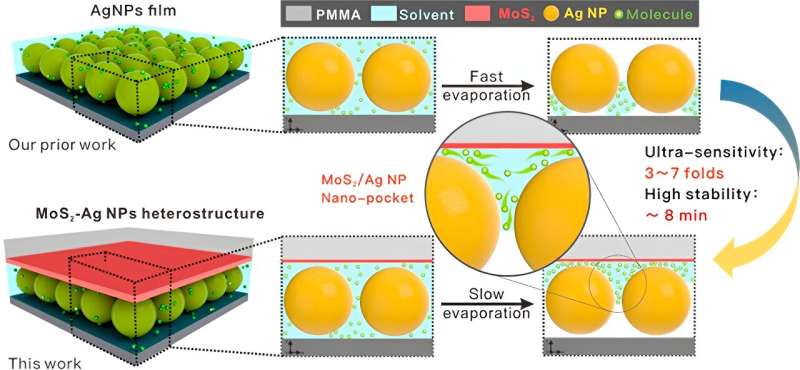This article has been reviewed according to Science X's editorial process and policies. Editors have highlighted the following attributes while ensuring the content's credibility:
fact-checked
peer-reviewed publication
proofread
Scientists suggest special nano-pocket for surface-enhanced Raman spectroscopy scattering detection

The research group of Yang Liangbao at the Institute of Health and Medical Technology, Hefei Institutes of Physical Science (HFIPS), Chinese Academy of Science (CAS) has recently developed a surface-enhanced Raman spectroscopy (SERMS) method to automatically capture target molecules in AgNP/MoS2 nano-pockets, which enables highly sensitive and long-duration dynamic detection of some chemical reaction processes.
The results were published in Analytical Chemistry and selected as the front cover.
Surface-enhanced Raman spectroscopy (SERS) is a kind of molecular spectroscopy with fast, highly sensitive, and fingerprint identification properties.
"This research is based on our previous SERS studies," said Prof. Yang Liangbao, "which we have been engaging in for years."
In this experiment, the team covered a large-area monolayer nanoparticle film with a two-dimensional material called MoS2, and created an AgNP/MoS2 nano "pocket." This nano pocket was then placed on the target molecules to be tested. Using a multi-physics field model and finite element simulation method, the team analyzed the electric field enhancement distribution of the AgNP/MoS2 nano pocket structure in both solution and air, as well as the dynamic process of solution evaporation.
They found that the nano pocket not only possessed a high density of hotspots but also had the ability to actively capture molecules. Compared to a single-layer Ag NP film, the addition of MoS2 slowed down the evaporation of the solution, extending the window of SERS detection and further enhancing the electric field. This structure enabled high sensitivity and stability in dynamic SERS detection for up to 8 minutes.
Additionally, this structure can be utilized for detecting anti-tumor drugs and monitoring structural changes of xanthine in serum.
The related methods are expected to be more applicable to the in-situ detection of substance transformations or other chemical reaction kinetics in biological systems, according to the team.
More information: Siyu Chen et al, Development of a MoS2/Ag NP Nanopocket to Trap Target Molecules for Surface-Enhanced Raman Scattering Detection with Long-Term Stability and High Sensitivity, Analytical Chemistry (2023). DOI: 10.1021/acs.analchem.3c00665
Journal information: Analytical Chemistry
Provided by Hefei Institutes of Physical Science, Chinese Academy of Sciences



















